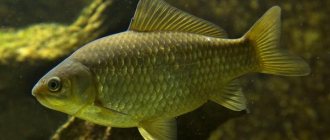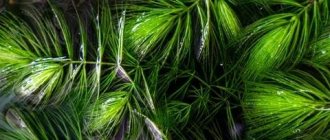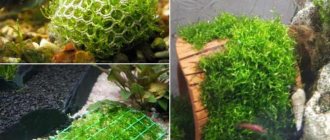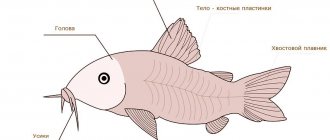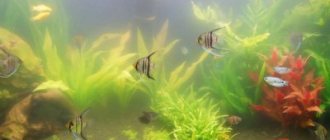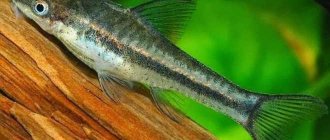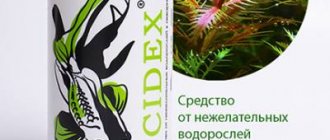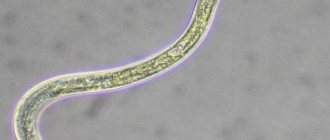Description
A species of freshwater ornamental fish from the carp family. The body size of pond inhabitants is on average 90–100 cm, less often 130 cm. In the aquarium, koi carps are small - 20–30 cm, but there are species up to 70 cm.
Breeders evaluate the appearance of koi carp. Body parts must obey certain proportions.
Body parts
Most species have a large, broad head with a blunt nose. The pectoral fins are highly developed. The body begins to narrow in the area of the dorsal fin. When viewed from above, the body looks even and proportional. Breeders look at the skin, the color should be bright, the skin should be healthy, and the spots on the body should be clearly limited and distributed evenly over the entire surface. The pattern on the body is commensurate with a carp.
How long do koi carps live?
Ornamental carps are long-lived, in captivity they live up to 35 years, with good care they can live up to 100. There are known cases of reaching 220 years.
Appearance
Since koi carp is the result of a very long selection, the requirements for its appearance are quite stringent. Professional owners of such fish first of all evaluate the overall proportions of the body, that is, the correct ratio of the sizes of the head, body, and tail.
Head . Almost all types of decorative Japanese carp (they are also sometimes called brocade carp because of the characteristic color and quality of the skin) have a large, blunt-nosed and wide head. In adult females, the head may be slightly wider, since their so-called cheeks quite often grow.
The body of a koi should ideally taper evenly from the massive shoulders (from the beginning of the dorsal fin) to the developed tail. This physique gives visual power to each individual.
Fins . Strong pectoral fins allow the large aquatic animal to balance well in the water flow. The dorsal fin is usually not too high, which is harmoniously combined with the overall size of the body.
The sizes of fish can vary: from 20 cm (aquarium species) to 0.9 m (when bred in ponds).
By the way, according to strict Japanese standards, decorative carp from 70 cm or more are considered real koi.
The weight of individuals, accordingly, can be different - from 4 to 10 kg. These fish live long enough compared to other ornamental species. In optimal conditions, they can easily live up to 30 years!
Color is what most fully characterizes Japanese beauties. The colors can be varied, but the colors must be rich. Individuals with an even color throughout the body are especially valued, but there are species with patterns on the back, sides and head, as well as striped decorative carps. Bright colors (red, blue, white, yellow and others) are the result of long and painstaking selection work.
Classification . It is by the coloring characteristics that professional koi breeders distinguish between the breeds of this family of carp, of which there are more than 60. For ease of classification, the wise Japanese have reduced all these varieties into 14 main groups, which have names in Japanese. In general, in the field of breeding and selection of these ornamental fish, professionals most often use special Japanese terminology.
Kinds
Koi look varied and interesting. Predominant colors:
- red;
- cream;
- black;
- white;
- cream;
- blue.
More than 80 breeds are known. Koi carp are divided into 16 groups based on similar characteristics.
- Kohaku. White fish with red-orange spots.
- Taise Sanseku. White koi carp with red and black spots.
- Seva Sanseku. Black carp with red and white splashes.
- Utsurimono. Black carp with colored spots.
- Bakko. Body color: red, orange, white or yellow. Dark spots are evenly distributed on the body.
- Tante. A distinctive feature is a red spot on the head. A smooth round spot is especially valued. The color is different.
- Asagi. Koi with bluish and gray scales on their back and a red or orange belly.
- Shusui. A type of mirror carp with two rows of large scales from head to tail.
- Koromo. Koi with red and black-red spots. Outwardly they resemble kohaku, they are distinguished by spots with dark edging.
- Kinginrin. Carps of different colors with pearlescent and golden tints. Shine is achieved by the special structure of the scales. There are individuals of gold and silver shades.
- Kawarimono. Inherent in carps that do not belong to existing breed standards.
- Fire. The color of ogons is monochromatic; there are fish of yellow, orange, red and gray colors.
- Hikari-moemono. Koi with a metallic sheen and various colors.
- Goshiki. Black carp with splashes of red, yellow or blue.
- Doitsu goyim. Varieties without scales or with rows of large scales, like mirror carp.
- Kumonryu. The name translates as “dragon fish”. Black koi with white spots.
Maintenance in the Russian climate
To breed Japanese carp in Russian conditions, choose adapted individuals raised in more severe climatic conditions than carp from China or Japan. The depth of the pond should be at least 2 m, while at the bottom it is necessary to dig a 0.5 m hole. This is necessary so that during hot periods the fish can hide in the cool, and in winter, on the contrary, in warmer water.
When the ambient temperature drops to +10 degrees, lasting at least 14 days, koi carp, which is kept in a pond, begin to be fed once a day. This is done so that the food does not rot in the fish’s stomach, because during this period all processes in the carp’s body slow down.
In cold weather, the pond is covered with polyethylene. Be careful not to form ice, otherwise the fish will suffocate.
We recommend reading
Glass aquarium fish
Diseases usually avoid koi carp. Sometimes owners encounter worms, fungal infections, ichthyophthyriasis, costiosis, and flukes.
Content
There are cases of keeping koi not only in home-made ponds, but also in illuminated city fountains. It is allowed to keep koi carp in an aquarium with high-quality and constant maintenance. You can't do without expensive equipment. Japanese carp are demanding when it comes to water purity. Water parameters:
- temperature 15–30 degrees;
- pH 7–7.5, during treatment of fish it is allowed to increase the value to 8;
- hardness 1–7.
Avoid sudden changes in water parameters. If not maintained correctly, wounds and small ulcers form on the body. Poor water quality leads to gill rot and other infectious diseases with fatal consequences. Signs of the onset of the disease are decreased appetite and lethargy. Koi are susceptible to ichthyophthyriasis, during which ciliates parasitize the skin. In infected fish, a swelling appears at the site where the parasite penetrates the skin. It is treated with a solution of table salt or malachite green.
Reservoir dimensions
Koi are active fish and require a lot of space for normal development. For every centimeter of a fish's body there is at least 5 liters of water. Keep in mind that fish grow as they live. Koi are kept in an aquarium of 500 liters or more.
Scenery
When decorating an aquarium, focus on the colorful inhabitants. Pisces look great against a plain background. Fish love to dig and move decorations. Think about the color combination in advance: bright fish look impressive against a dark background.
Limit yourself to a minimum of plants and accessories - excess design distracts from contemplating the koi and takes up space in the aquarium. Choose sandy or fine gravel soil.
Equipment
Equipment you will need:
- Filter. A large aquarium requires a powerful filter. Choose external devices. They are more powerful and provide high-quality filtration. You may need several devices for proper filtration.
- Compressor. Koi carps require oxygenation of the water. For filtration and aeration, purchase two different devices. You should not entrust aeration to a filter.
- Lamp. For the brightness of the color of koi, intense lighting and adherence to the light regime of the day are required.
Vegetation
Refrain from planting plants in the ground - carps will dig up the greens. Place several hanging pots in the aquarium at a distance of 15 cm from the bottom. Place plastic plants.
Keeping Koi Carps
Despite the fact that clean ponds are best suited for breeding koi carp, many domestic and foreign aquarists quite successfully keep such very beautiful ornamental fish at home.
Aquarium preparation, volume for koi fish
Koi carps are relatively unpretentious ornamental fish, and special attention should be paid to the cleanliness of the aquatic environment, to which they are very demanding. A complex running water system is not necessary, but weekly changes should amount to approximately 30% of the total contents of the aquarium.
For breeding koi, it is recommended to purchase aquariums with a capacity of about 500 liters with powerful and constant filtration in the form of a pair of external filters. Constant saturation of water with air is a necessary condition for keeping all cyprinids at home. The optimal pH level is 7.0-7.5 (neutral balance). Koi feel comfortable at water temperatures ranging from 15-30°C.
Bright and active koi carps look especially advantageous against a dark and plain background, which must be taken into account when choosing an aquarium option for keeping such fish.
Decor and vegetation
Aquarium soil can be represented by medium or fine sand. All bottom communications should be securely fixed with special silicone and sprinkled with a layer of sand. Abundant vegetation and bright decor will be unnecessary when keeping koi. It is quite possible to use pots with water lilies or other plants for decoration, which can be hung at a height of 10-15 cm from the bottom.
On a note! In aquarium conditions, koi carps rarely grow to too large a size, so their maximum length is usually only 25-35 cm.
Character and behavior of koi carp
Brocade carp are peaceful aquarium fish, keeping them as pets does not cause any difficulties or problems. Connoisseurs of such aquatic inhabitants, very unusual in appearance, often believe that these ornamental fish have intelligence, are able to recognize their owner and quickly get used to his voice.
Brocade carp are peace-loving aquarium fish.
If the feeding procedure is regularly accompanied by soft sounds in the form of light tapping on the glass, then the koi carp will remember them and will actively react when the time for the meal approaches.
Diet and nutrition for koi fish
Decorative pets are omnivores, so their daily diet should include both plant and animal foods. Natural foods used to feed koi carp can include bloodworms, small tadpoles, earthworms and frog eggs. It is this food that contains a large amount of proteins necessary for the growth and full development of any representatives of the carp family.
Compound feed for fish: composition, advantages, recipes: (read more)
It should be noted that it is forbidden to feed ornamental fish in too large portions, so experts recommend feeding them frequently, but in small quantities (about three or four times a day). Food that is not eaten by aquarium carp quickly decomposes in the water and causes the fish to develop diseases that are difficult to treat. As practice shows, it is quite possible not to feed koi carp for a week.
On a note! Not too frequent fasting has a beneficial effect on the health of pets, and the daily amount of food should not exceed 3% of the fish’s own weight.
Compatibility of Koi with other fish
Against the background of the elegant and bright color of koi, many other aquarium and pond fish look simple and inconspicuous. Carps transplanted from open reservoirs into aquarium conditions initially behave quite cautiously and fearfully, but the juveniles are able to adapt more easily and quickly. The adaptation process can be accelerated by adding bitterling, plecostomus, catfish and trout, mollies, goldfish, minnows, platies and sunfish to the carps.
Care
Like other inhabitants of reservoirs, brocade carp requires attention to the purity of the water and the composition and nutritional standards.
Feeding
Koi are omnivores. Combine dry and live food. Do not allow food to settle on the ground; carps should eat food within 5 minutes. The amount of food poured in should not exceed 3% of the total weight of aquarium fish. Feed 2-3 times a day in small portions. Suitable food:
- cereals;
- lettuce leaves;
- dandelion;
- worms;
- crustaceans Cyclops and Daphnia;
- shrimps;
- chicken eggs.
In cold times
Provide your carp with a comfortable winter. As the weather gets colder, carp prepare for hibernation, their appetite decreases, and their diet is dominated by algae. In pond conditions, do not lower the water temperature below 4 degrees; punch several holes in the ice, which you will provide with a heater and an aerator. Wintering is easier in an aquarium.
Nutrition
These ornamental cyprinids are practically omnivorous; they consume both plant and animal food.
Ideal as natural live food
- bloodworm,
- Artemia,
- earthworms,
- small tadpoles,
- frog caviar.
This is exactly the protein food that almost all carp eat in natural conditions.
However, in aquariums, experts recommend using the listed dishes as a gourmet food, and the main food should be special commercial food.
Moreover, some of them for carp contain not only all the necessary macro- and microelements, but also additives that enhance the color of the fish. Perhaps the most common are JBL food, among which are Pond Flakes, JBL Koi maxi, Koi midi, JBL Pond Vario and JBL Pond Coloron. They can be used constantly.
You should not overfeed your koi carp. It is better to give food more often (three times a day) and little. In this case, food residues will not remain and decompose in the aquarium, and the amount of waste products will not exceed the normal concentration.
In principle, you don’t have to feed koi at all for a whole week. Such fasting fasting will only benefit them.
Lighting should be intense. It is in bright light that the bright exotic coloring of brocade carp looks most advantageous. The choice of lamp type depends entirely on the preferences of the fish owner.
Compatibility
Koi are not compatible with many fish species. Choose neighbors of similar character and size:
- goldfish;
- Ancistrus;
- Plecostomus.
The greatest compatibility remains with other brocade carps. Little roommates will be eaten.
Carps are peaceful and active. During adaptation to the aquarium they are shy, but soon become active fish.
Description and origin
Experts have bred 80 breeds of koi carp, which are divided into 16 groups to simplify selection. To do this, they undergo an assessment of the shape of the head, fins, body color and general parameters. Very often such fish can be seen at exhibitions. For them, females are most often chosen, because they are most consistent in size and color, have equal sides of the body and fins proportional to it.
To put a koi carp on display, you should carefully examine the fish. It must be healthy and without defects in scales. It is recommended to evaluate the number of spots (characteristic of the breed), the depth of color and its tonality. Everything must be balanced. On small fish, small patterns and spots are assessed, and on large fish, spots and patterns of increased size, swimming style and posture are assessed.
You can also admire these bright fish in home aquariums and glass-enclosed ponds. They are in demand because... easy and unpretentious to care for. If such a fish is kept in an aquarium, its body length can reach 20 cm, but the color of the body will be a little faded. The size of the fish depends on the bulkiness of the aquarium, therefore, the larger the aquarium, the longer its resident will be. Therefore, it is recommended to purchase an aquarium for brocade carp with a capacity of 800-1000 liters or more. In such conditions, fish weighing 6 kg can be raised. When purchasing from 5-7 brocade carps, you should think about increasing the volume of the aquarium to 2 tons, taking into account further growth. Of course, you can keep only small fish, but then it is difficult to truly appreciate the luxurious appearance of decorative pets.
Breeding
Carp rarely breed in an aquarium. To breed koi at home, you need a huge tank. Reproduction occurs in spring and summer at a temperature of 20 degrees. Choose the most beautiful manufacturers. Mature individuals reach 23 cm, the male differs from the female:
- powerful pectoral fins;
- less weighty body;
- narrow head shape;
- the appearance of growths on the gills (tubercles).
When breeding, feed your koi carp live protein food and change the water frequently. Remember that parents are prone to eating eggs and fry. Prepare a container in advance in which to place the eggs. The fry begin to hatch a week after the eggs are laid. Due to their special structure, the fry are attached to the ground or plants and lie there until they hatch completely. When young individuals learn to swim on their own, they occasionally swim to the surface of the water, then start feeding. Take care of aeration and cleanliness of water.
Features of pond maintenance
Pond maintenance is optimal for carp. Pisces are calm, quickly get used to people and even willingly allow themselves to be touched. In an aquarium, due to the fact that koi cannot fully grow, they do not show all their beautiful characteristics.
If you have a pond on your property, we advise you to think about populating it with these beautiful fish.
Carps are kept in the pond year-round . The reservoir in the place where the fish will be in winter must have a depth of at least 250 cm and there should be no ice on the surface of the water. It is highly not recommended to break through ice; its formation should be prevented. With a pond depth of 250 cm or more, the water at the bottom will not cool below +4 degrees even in severe frost. If a body of water is covered with ice, then a sufficient amount of oxygen does not enter it and harmful gases accumulate. As a result, the fish die from oxygen starvation and poisoning. For normal wintering, it is enough that a small area of the water surface remains clear of ice.
For proper wintering of fish in the pond, it is recommended to install a pump that will enrich the water with oxygen and prevent ice from forming.
If the pond is shallow, then koi will not be able to winter in it. For the cold season, they should be transferred to an aquarium that is kept in a cool place.
Video: Wintering koi carp in a pond
The size of the pond needs to be significant, since the fish are active and need space for swimming. Trout, minnow and some types of catfish are suitable as neighbors for carp. Aggressive neighbors are unacceptable, as they can eat or injure young koi carp.
Adviсe
- Make sure that the surface on which the aquarium stands can support the weight of the pond. Keeping koi in an aquarium requires durable floors.
- When buying pet food, pay attention to the expiration date and compliance with storage conditions. Avoid loose feed.
- The water in the aquarium is free of cloudiness and foreign odors. If the water quality is low, increase filtration and aeration, and check the water with special tests.
- Fish sleep in complete darkness. Don't forget to turn off the lights at night.
- Combine biological and mechanical filtration. Purifying water with the help of colonies of beneficial bacteria will provide your pets with a full-fledged existence.
Koi carps are smart and charming aquarium fish. They remember the owner, feed from hands and even allow themselves to be petted. Feeding the fish can be accompanied by some sound, for example, knocking on the glass of the aquarium. Then the carp will react to the sound, realizing that it is time for lunch.
Previous Fishes8 common types of aquarium fish platies Next
FishGuppies and 19 compatible fish
Handsome and long-lived
Ornamental carp does not live in its natural environment. The Japanese koi lives in artificial reservoirs and aquariums, although other than color it has no other features that distinguish it from its wild counterparts.
There are more than 80 varieties of koi. Most are not considered elite. A total of 14 species of fish have categories that are assigned after several selective selections.
When choosing koi fish, pay attention to the proportionality of the body. The Japanese carp is characterized by a large head and a blunt nose. Adult females have a distinctive feature - their heads are usually wider than those of males due to the “cheeks”.
We recommend reading
Description and types of carp
In an elite ornamental carp, the body should gradually decrease from the dorsal fin to the tail. The fins on the ventral part of the body are powerful, the dorsal ones are low and streamlined.
The size of koi carp ranges from 20 cm for aquarium fish to 90 cm for pond koi. Some individuals reach impressive sizes - more than 1 meter. The weight of a young carp is 4 kg, and by adulthood it increases to 10 kg.
The average lifespan of Japanese koi carp is 3 decades. The age of individual individuals reaches 200 years, subject to excellent maintenance.
